
The food supply chain in the Asia-Pacific region is a sprawling network that plays a crucial role in feeding a diverse population. It includes a wide array of players, from local farmers to multinational corporations, all working together to move food from fields to consumers. This supply chain faces unique challenges, such as varying regulations and logistical hurdles across countries, requiring innovative solutions to ensure efficiency, safety, and sustainability. With its growing economy and population, the APAC region’s food supply chain is a vital component of global food security.
Decoding the Food Supply chain in APAC
Current Shifts: A Closer Look at Changing Supply Chain Realities
Precision agriculture and the integration of blockchain technology are two cutting-edge practices that are accelerating advancements in the APAC food supply chain by streamlining the route that food takes from farms to consumers.
The demand for sustainability is reshaping the current landscape, influencing political changes, health crises, and a consumer shift towards online shopping. As cities expand, the demand for nutritious and easily accessible food is on the rise.
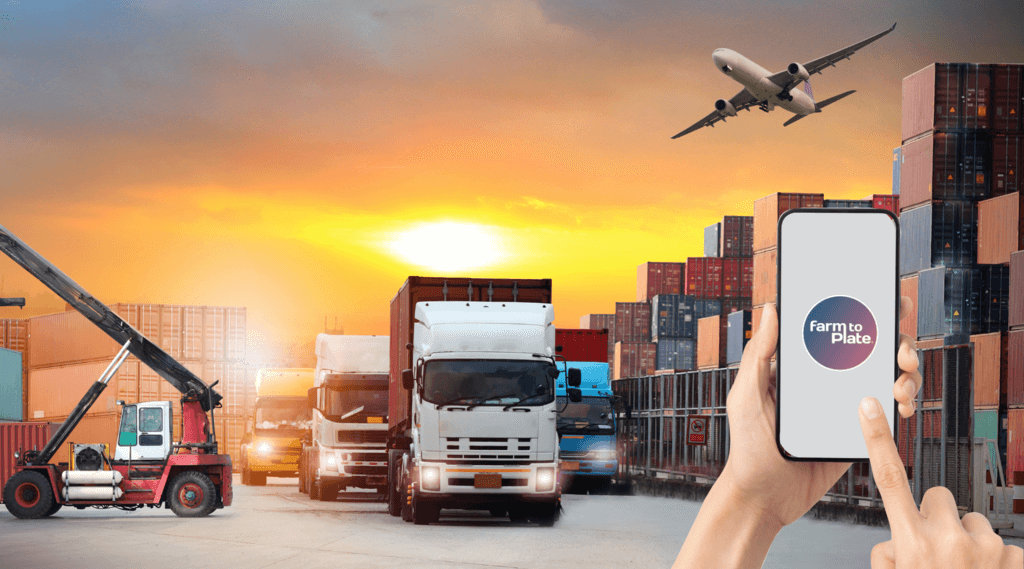

The Realities of Traceability Challenges
APAC’s food supply chain encounters hurdles due to diverse regulations, technologies, and cultural practices, hindering a unified traceability system. These complexities impede data sharing, procedural standardization, and cross-border collaboration, creating obstacles essential for a robust supply chain, including transparency, safety, and efficiency.
To address these challenges and strengthen their supply chains against unforeseen events, APAC nations collaborate to establish uniform standards.
Real-time Statistics in Asian Pacific Food Supply Chain Markets

While specifics vary by country due to their unique socio-political landscapes, reports indicate significant growth in the Asian Pacific food market.
Market Growth
The Asia-Pacific food market is projected to grow at a CAGR of around 7.2% from 2020 through 2025.
Supply Chain Transparency
Nearly 60% of Asian consumers rate food safety standards as extremely important, prompting the food industry to improve traceability.
Investment in Technology
Investment in supply chain technologies in the region is increasing but is still comparatively low at only around 5% of total global investment, suggesting substantial room for growth.
Pivotal Issues Affecting the Food Supply Chain
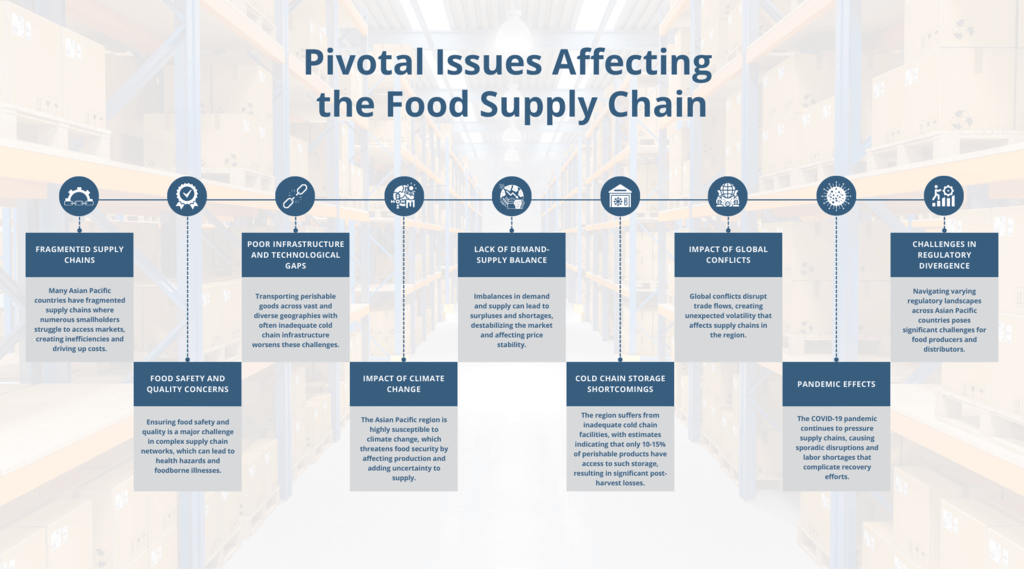
Fragmented Supply Chains
Many Asian Pacific countries have fragmented supply chains where numerous smallholders struggle to access markets, creating inefficiencies and driving up costs.
Food safety and quality concerns
Ensuring food safety and quality is a major challenge in complex supply chain networks, which can lead to health hazards and foodborne illnesses.
Poor infrastructure and technological gaps
Transporting perishable goods across vast and diverse geographies with often inadequate cold chain infrastructure worsens these challenges.
Impact of Climate Change
The Asian Pacific region is highly susceptible to climate change, which threatens food security by affecting production and adding uncertainty to supply.
Lack of demand-supply balance
Imbalances in demand and supply can lead to surpluses and shortages, destabilizing the market and affecting price stability.
Cold Chain Storage Shortcomings
The region suffers from inadequate cold chain facilities, with estimates indicating that only 10-15% of perishable products have access to such storage, resulting in significant post-harvest losses.
Impact of Global Conflicts
Global conflicts disrupt trade flows, creating unexpected volatility that affects supply chains in the region.
Pandemic Effects
The COVID-19 pandemic continues to pressure supply chains, causing sporadic disruptions and labor shortages that complicate recovery efforts.
Challenges in Regulatory Divergence
Navigating varying regulatory landscapes across Asian Pacific countries poses significant challenges for food producers and distributors.
Government Interventions in Asian Pacific Regions
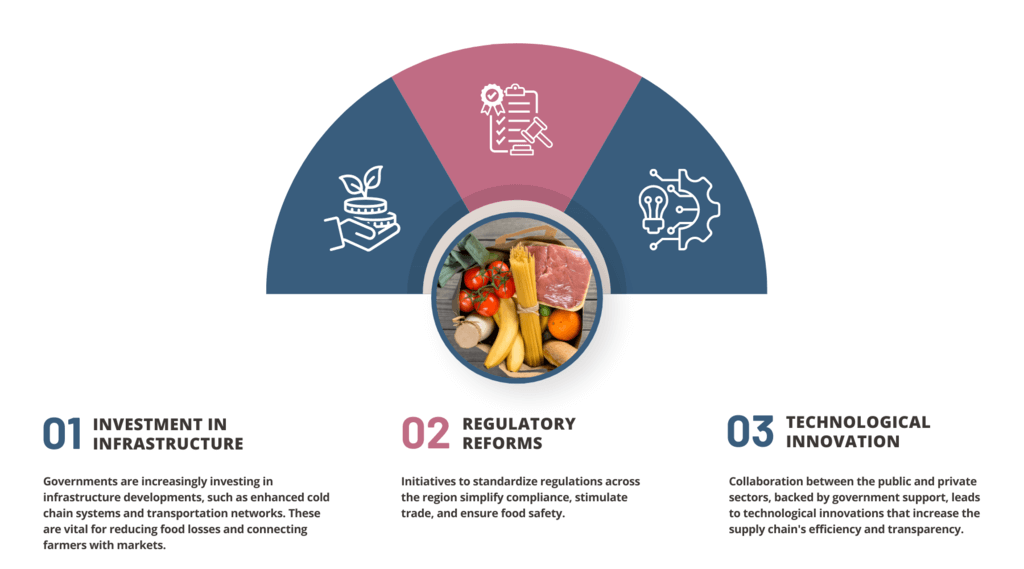
Government policies and interventions are pivotal in shaping the food supply chain landscape in the Asian Pacific regions.
Investment in Infrastructure:
Governments are increasingly investing in infrastructure developments, such as enhanced cold chain systems and transportation networks. These are vital for reducing food losses and connecting farmers with markets.
Regulatory Reforms:
Initiatives to standardize regulations across the region simplify compliance, stimulate trade, and ensure food safety
Technological Innovation:
Collaboration between the public and private sectors, backed by government support, leads to technological innovations that increase the supply chain’s efficiency and transparency.
Insights on the Fly: Getting Past Supply Chain Hurdles
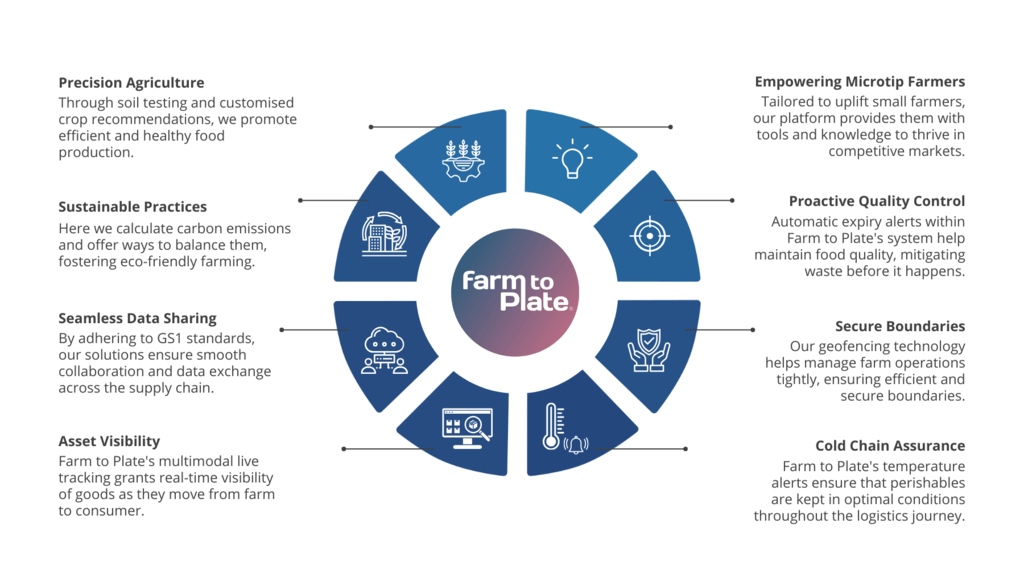
The enhancements Farm to Plate brings to the food supply chain in the Asian Pacific regions tackle existing challenges while unlocking substantial benefits. Governmental engagement, coupled with the incorporation of our innovative solutions, propels the region towards a more integrated, effective, and resilient food ecosystem, promising an improved outlook for the regional food and beverage market.
Precision Agriculture:
Through soil testing and customised crop recommendations, we promote efficient and healthy food production.
Sustainable Practices:
Here we calculate carbon emissions and offer ways to balance them, fostering eco-friendly farming.
Seamless Data Sharing:
By adhering to GS1 standards, our solutions ensure smooth collaboration and data exchange across the supply chain.
Asset Visibility:
Farm to Plate’s multimodal live tracking grants real-time visibility of goods as they move from farm to consumer.
Empowering Microtip Farmers:
Tailored to uplift small farmers, our platform provides them with tools and knowledge to thrive in competitive markets.
Proactive Quality Control:
Automatic expiry alerts within Farm to Plate’s system help maintain food quality, mitigating waste before it happens.
Secure Boundaries:
Our geofencing technology helps manage farm operations tightly, ensuring efficient and secure boundaries.
Cold Chain Assurance:
Farm to Plate’s temperature alerts ensure that perishables are kept in optimal conditions throughout the logistics journey.
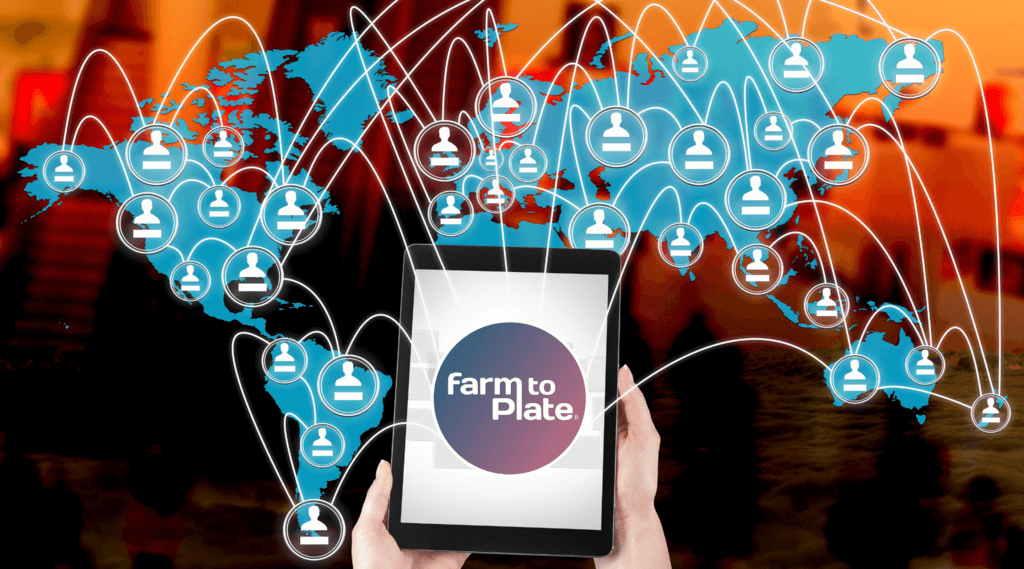
Farm to Plate leverages cutting-edge technology to tackle the pressing issues within the food supply chain, highlighting precision agriculture, sustainable practices, seamless data collaboration, and enhanced visibility. With features like empowering local farmers and maintaining quality and security through smart alerts and geofencing, Farm to Plate promises a transformative solution to the challenges of the modern food supply chain.